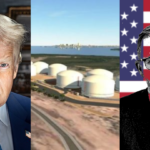US Pressures Australia to Increase Military Spending, As War Against China “May Be Imminent”

The Albanese government tossed the White House the keys to the Australian military early on in its first term of office and to such a degree that it’s difficult to consider our grovelling leaders could bend over backwards any further to appease their US masters. However, over recent days, Australian defence minister Richard Marles has been doing a pretty damn fine impression of a contortionist.
One might have considered that with the extremist Trump administration coming to power in the United States in January, that federal Labor might have tempered its enthusiasm for all things boding the soft colonisation of this country by the US empire both territorially and legislatively, but those concerns were all put to bed after Marles met with US secretary of defence Pete Hegseth last week.
Marles met Hegseth on 30 May 2025, ahead of the Shangri-La Dialogue, which is “Asia’s premier defence conference”. And when his US counterpart broached the question the Trump administration has been putting to all its “friends and allies” regarding whether they’ll lift their defence spending, Marles responded that it’s “a conversation that we are very willing to have”.
During the dialogue, Hegseth revealed Trump’s Indo Pacific policy, which not only aspires to all “friends and allies” increasing their military spend to 5 percent of GDP, but it also considers war with China “could be imminent”, which marks a distinct shift from the Biden administration’s position of war being “neither imminent or inevitable”, and Hegseth made certain that it’s time to choose a side.
Following Hegseth’s 31 May speech, Marles then conducted a brief interview with the Herald, in which he endorsed Trump’s Indo Pacific policy and admitted that defence spending increases had been discussed, but he wouldn’t confirm the figures involved. Yet, Hegseth announced the next day that he’d called on us to lift our “defence spending to 3.5 percent of GDP, as soon as possible”.
“Achieve peace through strength”
Hegseth, a former Fox News presenter, told those gathered at the Shangri-La Dialogue that Trump gave him a clear mission: “achieve peace through strength”. And according to the defence secretary, this means restoring the US “warrior ethos”, rebuilding the US military and reestablishing deterrence. To achieve these goals the Trump administration is upping its defence spend to $1 trillion a year.
The US defence secretary then laid out some “hard truths”, which involve the US not seeking conflict with Beijing, but rather China attempting “to become a hegemonic power”, which the East Asian giant has shown via its “massive military buildup” that includes its South China Sea militarisation and its “willingness to use force”, especially in terms of taking control of Taiwan potentially by 2027.
“Many countries are tempted by the idea of seeking both economic cooperation with China and defence cooperation with the United States,” Hegseth further stated, and hinted that this may not be an option for much longer. And while this statement was made to all politicians from various nations present, it distinctly describes Australia’s current policy position on the two global powers.
So, the crux of Trump’s Indo Pacific plan that involves all its “friends and allies” in the region appears to be a massive military buildup that results in the costs of war being so high that peace is the only viable option. “But if deterrence fails”, Hegseth added, the US Department of Defence is prepared to do what it “does best, fight and win, decisively”.
“NATO members are pledging to spend 5 percent of their GDP on defence – even Germany,” Hegseth stressed, as he appealed to the logic of politicians from the Indo Pacific. “So, it doesn’t make sense for countries in Europe to do that while key allies in Asia spend less on defence in the face of an even more formidable threat, not to mention North Korea.”
Social sector money to burn
After Hegseth revealed that Washington wants Australia to spend 3.5 percent of its GDP on defence via a US Department of Defence statement on Sunday, Australian PM Anthony Albanese announced on Monday that he rejected that proposal, and he underscored that his government was already lifting its military spending significantly from its current 2 percent of GDP to 2.33 percent by 2033-34.
The ABC crunched the numbers to find that raising military spending to 3.5 percent of GDP would mean that Australia would be spending AU$100 billion a year on defence, which is $40 billion more annually than it currently does.
The Albanese government already agreed to a $368 billion spend on entering into the AUKUS agreement with the US and the UK in March 2023. This significant increase in military spending already foreshadows huge cuts to the social sector over coming decades, with the goal being that our nation acquires eight nuclear-powered submarines (SSN), which also aim at deterring China.
Despite federal Labor having agreed to such an exorbitant military spend during dual cost-of-living and housing crises over its first term in office, it was recently returned to power with a resounding victory, so any concerns about military expenditure turning voters against the party aren’t going to weigh too heavily on the government during its current term in office.
The Trump administration also excels in bullying tactics to get its way. So, despite the Albanese government having made it clear that it would not be increasing its military expenditure past a hike to 2.33 percent of GDP by 2033-34, Hegseth continued to press Marles on the reform, and our defence minister caved to the point of conceding the nation is “very willing” to consider it.
Further, while Marles was prepared to share with the Australian public that an increase had been discussed, he also made clear that he wouldn’t be revealing the specific figures contemplated. However, he needn’t have bothered because Hegseth then took it upon himself to announce the figure to the planet the following day, which is another classic tactic of applying extra pressure.
And while the Australian prime minister responded to Hegseth’s further push by announcing that our government will decide how much of its GDP should be spent on militarisation, there are clear questions around how much say our government actually has over Australian military developments these days, along with foreign policy decisions, especially around joining US-led wars.
US controlled Australia
Right now, the US military is upgrading RAAF Base Tindall in the Northern Territory, where it plans to store six nuclear-capable B-52 bombers, and it’s also constructing a base at Western Australia’s HMAS Stirling, where it will establish Submarine Rotational Force-West, which will be a permanent rotating SSN presence made up of four US subs and one British boat.
Australia won’t know if any of the vessels the US military has stationed on this continent are or will be carrying any nuclear warheads, as Canberra respects Washington’s policy of ‘warhead ambiguity’.
As for the eight Australian owned SSN that were the key selling points of the AUKUS agreement, it appears increasingly unlikely that our nation will own any SSN. The US has promised to sell us three to five second hand US Virigina class SSN, if it makes its own quota of a fleet of 66 Virginia subs, however it’s way behind achieving this goal. And it can renege on the Australian deal at any time.
The other part of the AUKUS submarine deal involved the UK assisting Australia in the building of five new AUKUS SSN, but an assessment by the UK Infrastructure and Projects Authority released earlier this year finds this project coming to fruition increasingly unviable.
Australia is also set to invest around AU$4.6 billion into the submarine manufacturing industries in both the US and the UK, and our nation has already provided the first downpayments, which guarantee nothing in return, not even submarines, as there are no refunds if the SSN aren’t forthcoming, while the UK can also pull out of the AUKUS deal at any point.
The US is all about improving force posture these days, or its ability to launch wars from outside of its own territory. And Australia facilitated this when entering into the 2014 Force Posture Agreement, which has since established three local US force posture initiatives, which include increasing interoperability between the nations’ air forces and sees 2,500 US marines stationed near Darwin.
The third force posture initiative under the 2014 agreement permits the US to have unimpeded access to a classified list of local military facilities and areas, of which it takes complete control of if it decides to upgrade one. And that’s what’s occurring right now at RAAF Base Tindall, while currently, US jets making their way to the Middle East from the States, pitstop for refuelling over Australia.
The most important base the US has outside of its territory is Pine Gap, which is currently sharing intel via the US with Israel regarding Gaza. Pine Gap and another important US communications installation at North West Cape were born out of the 1951 ANZUS treaty, which unlike the NATO treaty does for European allies, does not guarantee US support for an Australia under attack.
The Albanese government also passed the Defence Trade Controls Amendment Bill 2024, which has created a licence-free military export environment between Australia and the US, which then led the congress to pass a law establishing this country as a domestic military source in US law, and that opens up privileged access to rare critical minerals to Washington.
Aye, aye sir
While last Thursday, Albanese was publicly knocking back press queries on whether Australia should be upping its defence spend further than planned, Marles, also the deputy PM, was telling US politicians the following day that we’re “very willing” to consider a much more significant increase to military spending, and Hegseth has already indicated, he’s going to keep pressing the point.
Not only have both major parties opened the floodgates to soft US military domination ever-increasingly over the last 70 years, but the last three years of the Albanese government have resulted in such significant inroads for the US military on this continent that the Pentagon, ultimately, calls the shots as far as the Australian military goes, and that includes on whether to join a war on China.
So, whether the Albanese government will eventually capitulate and agree to hike our miliary spend even further is not so much a matter of if, but rather how many times will US secretary of defence Hegseth have to press Marles to ensure that our nation does start upping the percentage of GDP it reserves for militarisation even further.
As Marles gleefully bragged at the last AUSMIN conference his government held with the Biden administration late last year, “American force posture now in Australia involves every domain: land, sea, air, cyber and space”.







